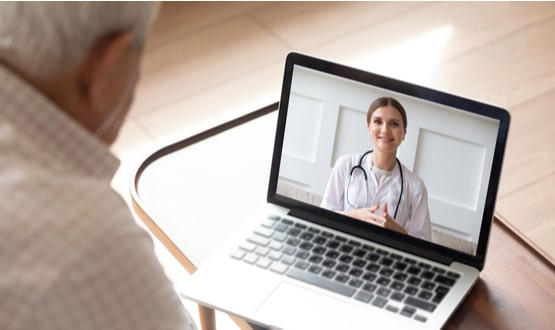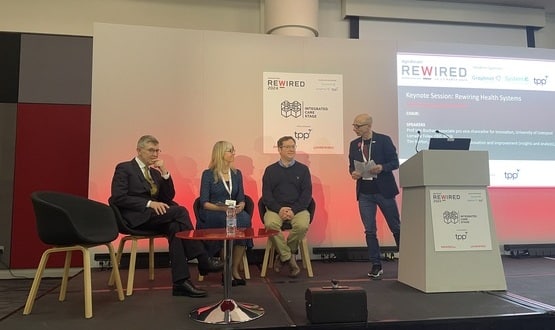Fast and furious tech adoption could break NHS services
- 21 July 2020

Covid-19 has accelerated the NHS technology agenda – including a sharp rise in video consultations. But we now need to learn from this to realise a bigger opportunity to create sustainable and intelligent digital patient pathways based on evidence, writes Alan Lowe, chief executive at Visionable.
The NHS has had to be very speedy in its technology response to the Covid-19 crisis, witnessing around five years’ worth of digital advancement in as many weeks. We have seen a health service that has changed its appetite for risk amidst the pressure to do things fast and furious when suddenly faced with the challenge of being physically removed from patients. But as the dust settles, the moment to pause and ask the questions needed to ensure services don’t become broken in the longer term is starting to arrive.
Covid-19 will fundamentally change commissioning approaches, forever. It already has. Until now, methods of commissioning pathways have persisted to rely on face to face interactions, with little thought for reimbursing and incentivising people who might want to create a digital pathway that could be life changing for patients and the people responsible for delivering their care.
Now we have a different lens – keeping people safe in their home – a fundamental new driver that will influence how services are commissioned regularly into the future. If we are to do that in an effective, sustainable way, we can’t just throw technology at the problem. We have to ask the right questions about the design of services, about where technology and people fit in that design, and we need to start learning quickly from the answers.
Catching up on five years’ of learning
With five years’ worth of tech adoption comes an equivalent breadth of learning for the NHS to catch up on.
Video technology is one notable area that has seen tremendous sudden growth as the NHS has had no choice but to adopt it speedily. But the health service now needs to understand where it hasn’t worked, as much as where it has.
People designing services now need to ask how they can intelligently integrate newly adopted technologies like video into the patient pathway, where it is and isn’t appropriate, and what they need to augment video with in order to allow services to fully utilise it.
That means understanding when blood tests, urinary tests or imaging is required, for example. It means asking if some of these examinations could be done by post or when a healthcare facility is required – if that can be a nearby facility to the patient, with other aspects of the pathway at home.
Augmenting that video might mean utilising mobile MRI scanners, approved blood pressure cuffs, Bluetooth scales, and other appropriate devices that could be located in the home.
It means thinking about people too – and particularly for healthcare professionals – whether they have the right skillsets in place so that a nurse visiting a patient’s home can perform various roles that removes the need for different specialists to enter that home. Can that nurse, for example, take a photograph of wound care, that prevents several colleagues unnecessarily entering the house?
It means thinking about a great many variables. And if a multi-disciplinary approach is needed – can we create virtual MDTs that maximise time effectiveness and availability for clinicians and that reduce their own exposure to risk of infection.
In all this we need less haste and more careful consideration as we move at pace – we cannot just throw these things into the wild. We need to employ healthcare system thinking – otherwise we risk doing things fast and breaking things.
We need appropriate devices that collect and provide the right information safely. We need to consider how to onboard datasets. And we need to think about how people use those devices, how it works for the citizen, what data the pathway needs, how that data will be used, how you manage that long term, and create a pathway that is congruent and based on user centred co-design.
The fundamental question to answer is – how can we un-constrain the geography of care safely?
Putting the citizen at the centre
Putting people at the centre almost sounds like a buzzword – perhaps because it’s something people in healthcare have been trying to achieve for a long time.
But if you put the Covid-19 predicament to one side, virtualised pathways still have enormous potential to change lives. And so responses to Covid-19 could now be more than replicating a physical meeting. This is our real opportunity for meaningful change.
Take the redesign of renal pathways as an example. Many people on renal pathways have historically been unable to work or remain in education because of the intensity of interaction with the hospital. They had to go to places – to hospital for tests, meetings and consultations. Virtualising that pathway has allowed people to remain in work or education.
We are now seeing less inconvenience for the patient as pathways start to digitise – from the risk of getting Covid to getting in the car and creating Co2 emissions – the downside of coming into the hospital is being gradually eliminated.
But for this to be done safely we cannot rush and buy any old video conferencing tech. We need to create a second generation of teleconsultation where the resources of the healthcare system are configured around the patient’s digital interaction with their providers.
There’s no denying this is a complex piece to solve from a technology point of view and a service provision perspective. We need to start to understand it now, we need to match clinical need to availability and we need to map it and blueprint what good looks like.




